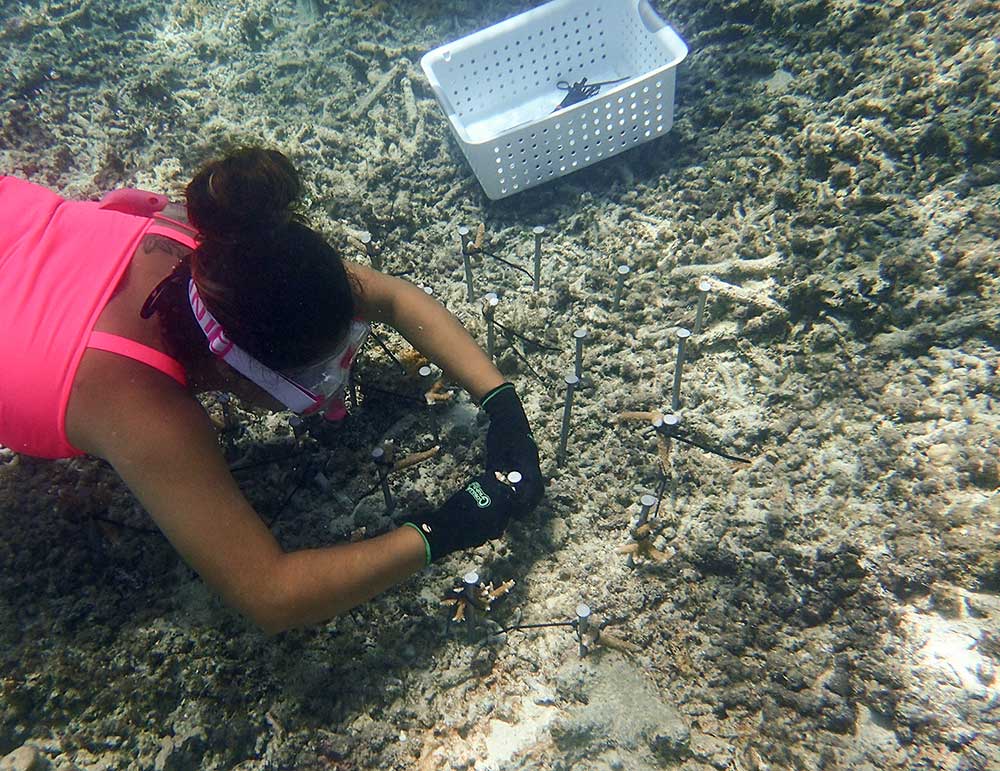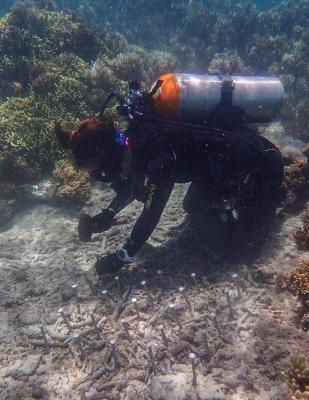Planting Corals with UOG Sea Grant: Student Leads Snorkeling Volunteers on Reef Restoration
Planting Corals with UOG Sea Grant: Student Leads Snorkeling Volunteers on Reef Restoration
Planting Corals with UOG Sea Grant: Student Leads Snorkeling Volunteers on Reef Restoration
 Volunteer Joyce Merino ties staghorn coral fragments to stakes. Photo credit: Nicole
Burns.
Volunteer Joyce Merino ties staghorn coral fragments to stakes. Photo credit: Nicole
Burns.
In 1969, The Beatles' drummer Ringo Starr memorably sang that he'd "like to be, under
the sea, in an octopus's garden, in the shade."
This past Earth Day, he could have been a lucky snorkeler to indeed be under the sea,
but in a staghorn coral garden at Piti Bomb Holes in Tepungan.
At the end of Guam's third International Coral Spawning Workshop on April 22, University
of Guam Master of Science in Biology student and UOG Sea Grant Fellow Nicole Burns piloted a volunteer effort to "plant" corals in a patch where
many had died.
Sea Grant Fellows, who are UOG graduate students receiving funds to support their
research, must implement outreach activities as part of their proposed work plans.
Historically Fellows have conducted public talks as outreach—and this was the first
to require mask, snorkel, fins, and duck dives.
Research for reef rehabilitation
Burns belongs to a cohort at Dr. Laurie Raymundo's lab expanding scientific knowledge
of corals, threats to their survival, and solutions for how to restore them on Guam's
reefs.
During her time at UOG, Burns has helped maintain a coral nursery, which resembles
those for plants. In the latter, growers sprout seeds and care for seedlings until
they are strong enough to survive outside their pots and in the ground. Similarly,
coral nurseries are environments where fragments can grow before transplanting them
into the reef.
Burns observes corals as they develop and then "outplants," or transfers them, to
degraded reef areas. A significant portion of her research explores conditions under
which corals optimally grow.
Given that rising ocean temperatures, pollution, and various human activities have
contributed to a 40% global decline in coral reefs, nurseries are potentially useful
and important sites for experiments and rearing.
April's eight-day International Coral Spawning Workshop, coordinated in part by Raymundo,
brought together specialists who learned about coral reproduction and how to raise
them in controlled conditions.  UOG student Nicole Burns preps coral plots by hammering stakes into the seafloor.
She had special permits—it it illegal to handle corals in Tepungan Bay. Photo credit:
Nicole Burns.
UOG student Nicole Burns preps coral plots by hammering stakes into the seafloor.
She had special permits—it it illegal to handle corals in Tepungan Bay. Photo credit:
Nicole Burns.
Earth Day, underwater
After a safety and dive briefing, Burns led six volunteers and supervisors to tour
the coral nursery. They snorkeled around the area's diverse habitats to check out
the various marine life, including hard and soft corals, fish, and algae.
For the next hour, volunteers then attached coral fragments to stakes with zip ties.
Stakes are at depths of about six feet, thus requiring participants to exercise some
breath-holding and aquatic skill.
Volunteer Joyce Merino pointed out that one of the more difficult aspects of outplanting
was "being able to snorkel with fins in such a shallow and small area and not destroying
the corals ourselves with all the kicking."
Indeed, Burns mentions that water enthusiasts can help reefs by not disturbing or
breaking the corals.
"Because corals take so long to grow, it is imperative that we let them do it in peace.
By knocking into and breaking corals, we could be destroying decades, or even centuries-worth
of growth, within seconds," she says.
Volunteers can return to the garden plots a few months or years from now, hopefully
to see their work flourishing in Tepungan's clear waters.
UOG Sea Grant and event coordinators note that activities were conducted with permits
from the Department of Agriculture. In marine preserve areas (MPAs) such as Tepungan,
it is illegal to handle corals. In non-MPA areas, residents are also advised not to
handle corals as they are fragile animals. Touching, stepping on, or otherwise manipulating
them can cause damage to the reef.
For more information about Sea Grant Fellows or science-based community education
events, contact Marie Auyong atauyongm@triton.uog.edu.
The National Sea Grant College Program is a partnership between universities and the
Federal Government’s National Oceanic and Atmospheric Administration (NOAA), an agency
within the Department of Commerce. The Sea Grant network includes more than 3,000
scientists, engineers, public outreach experts, educators, and students. Based in
the UOG Cooperative Extension & Outreach Service, UOG Sea Grant brings the science
of coastal resources to Guam’s people as one of 33 programs across the nation. See
www.cnas-re.uog.edu for more information.
